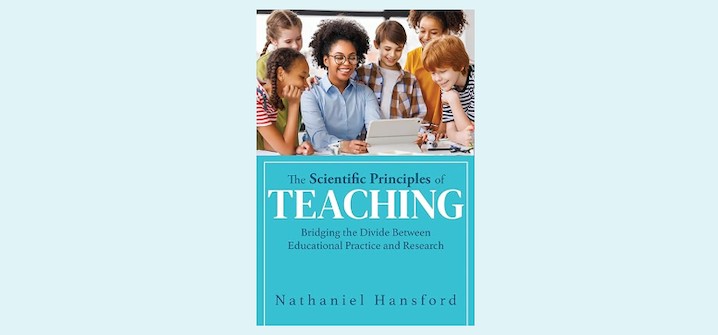The Scientific Principles of Teaching: Bridging the Divide Between Educational Practice and Research
By Nathaniel Hansford
(Solution Tree Press, 2024 – Learn more)
Reviewed by Sarah Pennington

 As a former teacher and current teacher educator, I am often faced with misconceptions regarding teaching and learning. While there are books that cover many of these misconceptions, I had yet to find a single resource for addressing some of the most common in my experience.
As a former teacher and current teacher educator, I am often faced with misconceptions regarding teaching and learning. While there are books that cover many of these misconceptions, I had yet to find a single resource for addressing some of the most common in my experience.
Thus I was excited to see The Scientific Principles of Teaching: Bridging the Divide Between Educational Practice and Research. This is a text I will be recommending to colleagues in pk-12 and higher education due to its reader-friendly and well-researched content.

 Nathaniel Hansford starts the introduction by sharing his own experiences as a teacher, including on-going education to further develop his teaching knowledge and toolbox. These experiences, as well as his own observations regarding a lack of research-informed instruction in his professional development, led him to begin reading more, conducting meta-analyses of research, and launching a podcast with a colleague (Pedagogy Non Grata). This introduction both sets the stage for the book and establishes Hansford’s credentials as both an educator and researcher.
Nathaniel Hansford starts the introduction by sharing his own experiences as a teacher, including on-going education to further develop his teaching knowledge and toolbox. These experiences, as well as his own observations regarding a lack of research-informed instruction in his professional development, led him to begin reading more, conducting meta-analyses of research, and launching a podcast with a colleague (Pedagogy Non Grata). This introduction both sets the stage for the book and establishes Hansford’s credentials as both an educator and researcher.
The first two chapters provide information to support educators in being informed readers of research. This includes clarifying the difference between evidence-based and research-based products and strategies, outlining the main approaches to educational research (qualitative, quantitative, and synthesis), as well as explaining sample size, effect size, and how to critically consider these and other elements of educational research.
Chapter 3 identifies “five core principles behind most evidence-based teaching methods” (p. 28). These are based on analysis of multiple meta-analytic studies and are broad while still being useful. They are:
- Quality Time Under Instruction – All students need to be exposed to information, but the amount of time may vary by student and/or content. Among strategies that can be used to increase the amount of time students engage with materials are jigsaw, repeated reading, and reciprocal teaching.
- Clarity of Expectations – Providing clear expectations to student using tools such as success criteria through clear rubrics.
- Specificity of Teaching – Both teaching and assessment must focus on the identified learning target(s).
- Appropriately Challenging Curriculum – We can hold high expectations for all students while also providing the scaffolding needed to help students meet these expectations.
- Reflective Teaching Practices – Reflective teaching provides opportunities for educators to build their knowledge and self-efficacy by identifying areas for growth and engaging in professional development and collaboration with colleagues.
Chapters 4-14 each address a specific topic or belief in education and provide an overview of the evidence (or lack thereof) for each topic, along with what this means for classroom educators.
Chapter 4 addresses the concept of IQ and IQ tests, including who is qualified to conduct and interpret these tests, while chapter 5 focuses on growth mindset, the mixed research behind it, and the benefits in spite of this.
Chapter 6 focuses on providing feedback to students and offers a list of practical tips for teachers to use feedback effectively without it becoming all-consuming. Chapter 7 investigates active and passive learning and the importance of both in daily instruction.
Chapter 8 discusses special education, including the research behind mainstreaming students with learning differences into general education classes and pullout instruction in which these students receive instruction in a dedicated setting. This chapter also addresses misconceptions around special education and considerations for teaching students with learning disabilities.
In Chapter 9, Hansford discusses cooperative learning, including the various benefits to students outside of academic achievement, such as increased time on task and stronger bonds with peers. Developmentally appropriate practice, the focus of chapter 10, is discussed mainly in terms of early reading instruction and early childhood education in general and is shown to not be an evidence-based approach.
Chapter 11 (Action Research Frameworks) provides insight into three different action research frameworks, with much of the subsequent discussion focused on Response to Intervention (RTI) and strategies for effective implementation of RTI as an action research framework.
Chapter 12 is, hands down, my favorite chapter. It dispels the learning styles myth through a clear discussion of Multiple Intelligences Theory and its development, the neuroscience behind multiple intelligences, and the potential negative impacts of teaching to learning styles.
Chapter 13 looks at constructivist teaching and traditional teaching, beginning with clearly defining both and identifying specific tools and approaches that fall under each category. Hansford then dives into meta-analysis of these approaches, discussing the findings and limitations of current research on the two views of teaching.
Chapter 14 considers the research behind differentiated instruction, including ability grouping, grade skipping, and intervention grouping.
Chapter 15 explains secondary meta-analysis of popular pedagogical approaches in reading and mathematics, including consideration of the ease with which each can be implemented. Chapters 16 and 17 discuss educational systems around the world, providing cautions for making comparisons between systems.
Hansford’s Epilogue provides six big takeaways synthesized from the information throughout the book, with references for specific research studies that provide evidence for his six points.
Overall, I appreciate both the information and layout of this book. Each chapter includes summary points and reflection questions. The reflection questions push the reader to consider how the information in the chapter can be applied to their own context and how to synthesize this information with what they already know or believe. As I read through the book, I kept some sticky notes handy to mark pages with figures or information I wanted to be able to find again quickly.
Sarah E. Pennington, Ph.D. is an associate professor in teacher education at Montana State University. In addition to facilitating coursework for preservice teachers at the undergraduate and graduate level, she also teaches research methods courses to doctoral students. Her current research focuses on middle grades education and how various community groups (students, caregivers, and school staff) perceive their school’s efficacy in supporting young adolescents.









